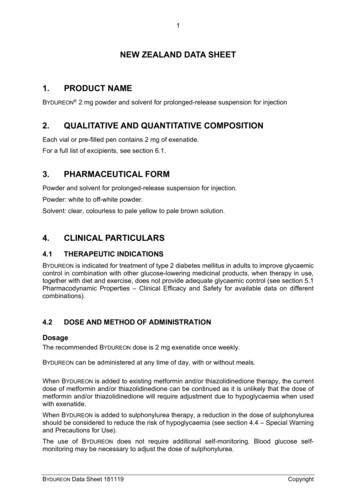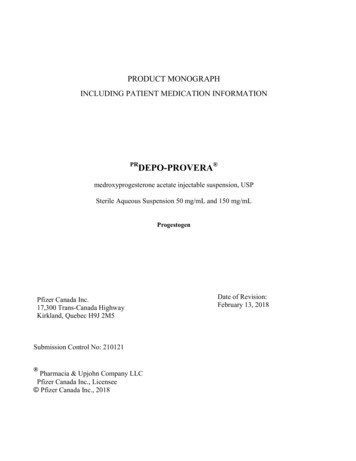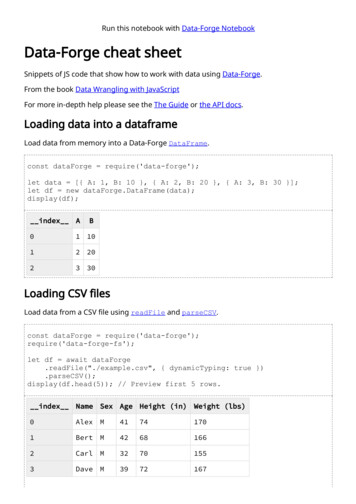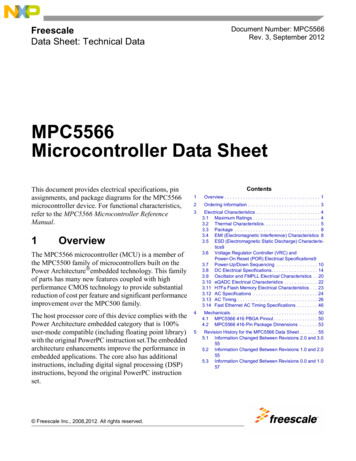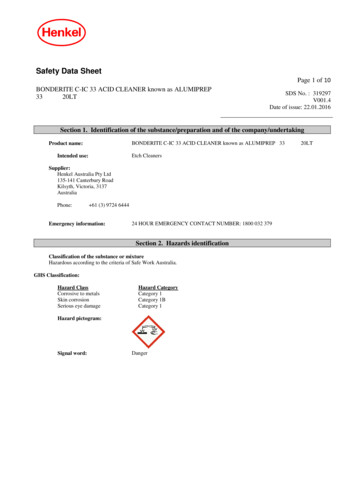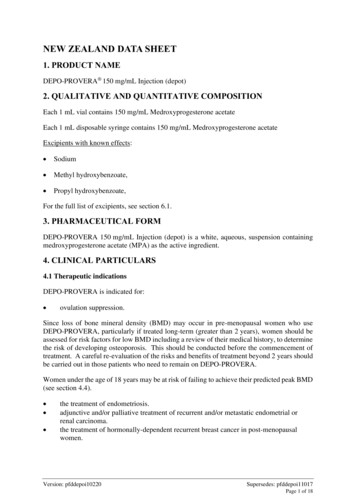
Transcription
NEW ZEALAND DATA SHEET1. PRODUCT NAMEDEPO-PROVERA 150 mg/mL Injection (depot)2. QUALITATIVE AND QUANTITATIVE COMPOSITIONEach 1 mL vial contains 150 mg/mL Medroxyprogesterone acetateEach 1 mL disposable syringe contains 150 mg/mL Medroxyprogesterone acetateExcipients with known effects: Sodium Methyl hydroxybenzoate, Propyl hydroxybenzoate,For the full list of excipients, see section 6.1.3. PHARMACEUTICAL FORMDEPO-PROVERA 150 mg/mL Injection (depot) is a white, aqueous, suspension containingmedroxyprogesterone acetate (MPA) as the active ingredient.4. CLINICAL PARTICULARS4.1 Therapeutic indicationsDEPO-PROVERA is indicated for: ovulation suppression.Since loss of bone mineral density (BMD) may occur in pre-menopausal women who useDEPO-PROVERA, particularly if treated long-term (greater than 2 years), women should beassessed for risk factors for low BMD including a review of their medical history, to determinethe risk of developing osteoporosis. This should be conducted before the commencement oftreatment. A careful re-evaluation of the risks and benefits of treatment beyond 2 years shouldbe carried out in those patients who need to remain on DEPO-PROVERA.Women under the age of 18 years may be at risk of failing to achieve their predicted peak BMD(see section 4.4). the treatment of endometriosis.adjunctive and/or palliative treatment of recurrent and/or metastatic endometrial orrenal carcinoma.the treatment of hormonally-dependent recurrent breast cancer in post-menopausalwomen.Version: pfddepoi10220Supersedes: pfddepoi11017Page 1 of 18
4.2 Dose and method of administrationOvulation suppressionDEPO-PROVERA should be vigorously shaken just before use to ensure that the dose beingadministered represents a uniform suspension. The IM suspension is not formulated forsubcutaneous injection.The recommended dose is 150 mg of DEPO-PROVERA every 3 months administered by IMinjection in the gluteal or deltoid muscle. The initial injection should be given during the first5 days after the onset of a normal menstrual period; within 5 days post-partum if not breastfeeding; or if exclusively breast-feeding at or after 6 weeks post-partum.It is recommended that physicians or others directly responsible for these patients advise themat the beginning of treatment that their menstrual cycle may be disrupted, that irregular andunpredictable bleeding or spotting are produced, but that this usually decreases to the point ofamenorrhoea as treatment with DEPO-PROVERA continues without other therapy beingrequired.Routine or long-term cyclic use of supplemental estrogens with DEPO-PROVERA is notrecommended. Excessive or prolonged bleeding which becomes troublesome to the patientcan usually be controlled by the administration of oral or parenteral estrogens in the equivalentof 0.05 mg to 0.1 mg ethinylestradiol daily for 7 to 21 days. This therapy can be continued for1 to 2 cycles, but should not be considered for long-term administration.Based on limited experience, some investigators favour the use of a second injection of DEPOPROVERA before 90 days to control troublesome bleeding. The third and subsequentinjections should be administered at separate 90 day intervals.If abnormal bleeding persists, appropriate investigation should be instituted to rule out thepossibility of organic pathology. Uterine curettage may be required on rare occasions.EndometriosisThe recommended dose of DEPO-PROVERA given intramuscularly is 50 mg weekly or100 mg every 2 weeks for at least 6 months.Endometrial and renal carcinomaDoses of 500 mg to 1000 mg of DEPO-PROVERA intramuscularly per week arerecommended initially. If improvement is noted within a few weeks or months and the diseaseappears stabilised, it may be possible to maintain improvement with 500 mg per week or less.DEPO-PROVERA is not recommended as primary therapy, but as adjunctive and palliativetreatment in advanced inoperable cases including those with recurrent or metastatic disease.Breast cancerThe recommended dosage schedule is DEPO-PROVERA 500 mg to 1000 mg per dayintramuscularly for 28 days. The patient should then be placed on a maintenance schedule of500 mg twice weekly as long as she is responding to treatment. Response to hormonal therapy(DEPO-PROVERA) for breast cancer may not be evident until 8 to 10 weeks of therapy.Treatment with DEPO-PROVERA should be terminated should rapid progression of diseaseoccur at any time during therapy.Version: pfddepoi10220Supersedes: pfddepoi11017Page 2 of 18
Women should be assessed for risk factors for low BMD when treated for ovulationsuppression or endometriosis. If these are found to be present, a full risk-benefit evaluationshould be undertaken by the prescriber to determine the appropriateness of using DEPOPROVERA. In women with significant lifestyle and /or medical risk factors for osteoporosis,other methods of contraception should be considered prior to use of DEPO-PROVERA.BMD should also be evaluated when considering continuing DEPO-PROVERA forcontraception or treatment of endometriosis beyond 2 years. An evaluation of BMD may alsobe appropriate in some patients who use DEPO-PROVERA long-term for oncologyindications.Paediatric populationDEPO-PROVERA is not indicated before menarche. Data are available in adolescent females(12 to 18 years) (see section 5.1, Clinical trial data). The safety and effectiveness of DEPOPROVERA are expected to be the same for postmenarcheal adolescent and adult females.Use in hepatic insufficiencyNo clinical studies have evaluated the effect of hepatic disease on the pharmacokinetics ofMPA. However, MPA is almost exclusively eliminated by hepatic metabolism and steroidhormones may be poorly metabolised in patients with severe liver insufficiency (see section4.3).Use in renal insufficiencyNo clinical studies have evaluated the effect of renal disease on the pharmacokinetics of MPA.However, since MPA is almost exclusively eliminated by hepatic metabolism, no dosageadjustment should be necessary in women with renal insufficiency.4.3 ContraindicationsDEPO PROVERA is contraindicated in patients with: thrombophlebitis, thromboembolic disorders, cerebral apoplexy or patients with a pasthistory of these conditions known or suspected pregnancy (see section 4.4) missed abortion undiagnosed vaginal bleeding known or suspected malignancy of the breast (when used for ovulation suppression orgynaecology indications) undiagnosed breast pathology undiagnosed urinary tract bleeding severe uncontrolled hypertension severe liver dysfunction known hypersensitivity to MPA or any component of the injection (see section 6.1).Version: pfddepoi10220Supersedes: pfddepoi11017Page 3 of 18
4.4 Special warnings and precautions for useThromboembolic disordersDEPO-PROVERA has not been causally associated with the induction of thrombotic orthromboembolic disorders (thrombophlebitis, cerebrovascular disorders, pulmonary embolism,and retinal thrombosis), however, MPA is not recommended in any patient with a history ofvenous thromboembolism (VTE). The physician should be alert to the earliest manifestationsof thrombotic or thromboembolic disorders. Should any of these occur or be suspected, thedrug should be discontinued immediately.Ocular disordersMedication should not be readministered pending examination if there is a sudden partial orcomplete loss of vision, or if there is a sudden onset of proptosis, diplopia, or migraine. Ifexamination reveals papilloedema or retinal vascular lesions, medication should not bereadministered.Bleeding irregularitiesMost women using DEPO-PROVERA experience disruption of menstrual bleeding patternsfollowing the administration of either a single or multiple doses of MPA (e.g., irregular orunpredictable bleeding/spotting, rarely, heavy or continuous bleeding). If unexpected vaginalbleeding occurs or abnormal bleeding persists or is severe, appropriate investigations shouldbe instituted to rule out the possibility of organic pathology and appropriate treatment shouldbe instituted when necessary.As women continue using DEPO-PROVERA fewer experience irregular bleeding and moreexperience amenorrhoea. By month 12, amenorrhoea was reported by 57% of women, and bymonth 24, amenorrhoea was reported by 68% of women using DEPO-PROVERA.Infertility and anovulation with amenorrhoea and/or erratic menstrual patterns may persist forperiods of up to 18 months and occasionally longer following either single or multipleinjections of DEPO-PROVERA.Loss of BMDContraception and endometriosisUse of DEPO-PROVERA reduces serum estrogen levels in premenopausal women and isassociated with a statistically significant loss of BMD as bone metabolism accommodates to alower estrogen level. Decreases in serum estrogen due to DEPO-PROVERA may result in adecrease in BMD in a pre-menopausal woman and may increase her risk for developingosteoporosis later in life.Bone loss may be greater with increasing duration of use and may not be completely reversiblein some women. It is unknown if use of DEPO-PROVERA during adolescence and earlyadulthood, a critical period of bone accretion, will reduce peak bone mass. In both adult andadolescent females, the decrease in BMD during treatment appears to be substantiallyreversible after DEPO-PROVERA is discontinued and ovarian estrogen production increases.After discontinuing Depo-Provera injection in adolescents, full recovery of mean BMDrequired 1.2 years at the lumbar spine, 4.6 years at the total hip and 4.6 years at the femoralneck (see section 5.1, Clinical trial data).In adults, BMD was observed for a period of 2 years after DEPO-PROVERA injection wasdiscontinued and partial recovery of mean BMD towards baseline was observed at total hip,Version: pfddepoi10220Supersedes: pfddepoi11017Page 4 of 18
femoral neck and lumbar spine (see section 5.1, Clinical trial data). A large observationalstudy of female contraceptive users showed that use of Depo-Provera injection has no effecton a woman’s risk for osteoporotic or non-osteoporotic fractures (see section 5.1, Clinical trialdata).DEPO-PROVERA should only be used as a long-term (e.g., longer than 2 years) contraceptivemethod or treatment for endometriosis if other contraceptive methods or endometriotictreatments are inadequate. BMD should be evaluated when a female needs to continue to useDEPO-PROVERA long term. In adolescent females, interpretation of BMD results shouldtake into account patient age and skeletal maturity. Since loss of BMD may occur in premenopausal women who use DEPO-PROVERA long-term (greater than 2 years) a risk/benefitassessment, which also takes into consideration the decrease in BMD that occurs duringpregnancy and/or lactation, should be considered (see section 5.1, Clinical trial data).Other contraceptive methods or endometriotic treatments should be considered in therisk/benefit analysis for the use of DEPO-PROVERA in women with osteoporotic risk factorssuch as: chronic alcohol and/or tobacco usechronic use of drugs that can reduce bone mass, e.g., anticonvulsants or corticosteroidslow body mass index or eating disorder, e.g., anorexia nervosa or bulimiametabolic bone diseasestrong family history of osteoporosis.OncologyThere are no studies on the BMD effects of high doses of parenteral DEPO-PROVERA foroncology use.However, 2 clinical studies of adult women of childbearing potential and of adolescent femalesgiven DEPO-PROVERA 150 mg IM every 3 months, for contraception, demonstratedsignificant decreases in BMD (see section 5.1, Clinical trial data). Decreases in serum estrogendue to DEPO-PROVERA may result in a decrease in BMD in a pre-menopausal woman andmay increase her risk for developing osteoporosis later in life.An evaluation of BMD may be appropriate in some cancer patients who use DEPO-PROVERAlong term.It is recommended that all patients have adequate calcium and vitamin D intake.Cancer risksLong-term case-controlled surveillance of users of DEPO-PROVERA found slight or noincreased overall risk of breast cancer and no overall increased risk of ovarian, liver, or cervicalcancer. There was a prolonged effect of reducing the risk of endometrial cancer in thepopulation of users, with a relative risk (RR) of 0.21 (95% Confidence Interval [CI] of 0.060.79). This protective effect lasts for at least 8 years after the cessation of DEPO-PROVERAuse.The overall RR of breast cancer associated with the use of DEPO-PROVERA appears to be1.2 (95% CI 0.96-1.52). However, an increased RR of 2.19 (95% CI 1.23-3.89) has beenassociated with use of DEPO-PROVERA in women whose first exposure to the drug waswithin the previous 4 years and were under 35 years of age. The RR increases in women agedVersion: pfddepoi10220Supersedes: pfddepoi11017Page 5 of 18
between 25 and 34 years of age (RR of 2 (95% CI 1.0-3.8) and rises to 4.6 (95% CI 1.4-15.1))in women aged less than 25 years with more than 2 years exposure to DEPO-PROVERA. Therisk of breast cancer was comparable in similar groups of women who used either DEPOPROVERA or an oral contraceptive.The Australian Institute of Health & Welfare report, between 1983 to 1985, an averageincidence rate for breast cancer of 20.97/100,000 in Australian women, aged 30 to 34 years. ARR of 2.19 increases the possible risk from 20.97 to 45.92 cases per 100,000 women. Theattributable risk, therefore, is 24.95 per 100,000 women per year.The overall, non-significant, relative rate of invasive squamous cell cervical cancer in womenwho ever used DEPO-PROVERA was estimated at 1.11 (95% CI 0.95-1.28). A statisticallyinsignificant increase in RR estimates of invasive squamous cell cervical cancer has beenassociated with the use of DEPO-PROVERA in women who were first exposed before the ageof 35 years (RR 1.22 to 1.28 and 95% CI 0.93-1.70). No trends in risk with duration of use ortimes since initial or most recent exposure were observed.Additional precautions for oncology patients.MPA may produce cushingoid symptoms.Some patients receiving high dose MPA, used in the treatment of cancer, may exhibitsuppressed adrenal function. MPA may decrease ACTH and hydrocortisone blood levels.Animal studies show that MPA possesses adrenocorticoid activity.Accidental pregnanciesInfants from unintentional pregnancies that occur 1 to 2 months after injection of DEPOPROVERA may be at increased risk of low birth weight, which in turn, is associated with anincreased risk of neonatal death. Because there is a low incidence of pregnancies in women onMPA, the attributable risk is low. There is no definitive information for the other formulationsof MPA.A significant increase in polysyndactyly and chromosomal anomalies was observed amonginfants of DEPO-PROVERA users, the former being most pronounced in women under30 years of age. The unrelated nature of these defects, the lack of confirmation from otherstudies, the distant preconceptual exposure to DEPO-PROVERA, and the chance effects dueto multiple statistical comparisons, make a causal association unlikely.Ectopic pregnancyAs with all forms of hormonal contraception, health-care providers should be alert to thepossibility of an ectopic pregnancy among women using DEPO-PROVERA who becomepregnant or complain of severe abdominal pain.Sexually transmitted infectionsDEPO-PROVERA 150 mg/mL is intended to prevent pregnancy. Women should becounselled that DEPO-PROVERA does not protect against sexually transmitted infections(STIs) including HIV infections (AIDS) but equally, DMPA is a sterile injection and, used asdirected, will not expose them to sexually transmitted infections. Safer sex practices includingcorrect and consistent use of condoms reduce the transmission of STIs through sexual contact,including HIV.Version: pfddepoi10220Supersedes: pfddepoi11017Page 6 of 18
In all situations where cessation of therapy is warranted, the physician should be aware of theslow elimination of the depot formulation.Anaphylactic and anaphylactoid reactionsAnaphylactic and anaphylactoid reactions have occasionally been reported in patients treatedwith IM MPA.Physical examinationA complete medical and family history should be taken before the initiation of any hormonetherapy. The pre-treatment and periodic physical examination should include special referenceto blood pressure, breasts, abdomen and pelvic organs, including cervical cytology(Papanicolaou smear).Fluid retentionDEPO-PROVERA may cause some degree of fluid retention, therefore, caution should beexercised in treating any patient with a pre-existing medical condition that might be adverselyaffected by fluid retention, such as epilepsy, migraine, asthma, or cardiac or renal dysfunction.Breakthrough bleedingUnexpected vaginal bleeding during therapy with DEPO-PROVERA should be investigated.Breakthrough bleeding is likely to occur in patients being treated for endometriosis. No otherhormonal intervention is recommended for managing this bleeding. Non-functional causesshould also be borne in mind and in cases of undiagnosed vaginal bleeding, adequate diagnosticmeasures are indicated.Carbohydrate metabolismSome patients receiving DEPO-PROVERA may exhibit a decreased glucose tolerance. Themechanism of this decrease is obscure. For this reason, diabetic patients should be carefullyobserved while receiving such therapy.CNS disorders and convulsionsPatients with a history of treatment for clinical depression should be carefully monitored whilereceiving DEPO-PROVERA therapy and the drug discontinued if the depression recurs to aserious degree.Weight changesThere was a tendency for women to gain weight while on therapy with MPA. From an initialaverage body weight of 61.8 kg women who completed 1 year of therapy with DEPOPROVERA gained an average of 2.45 kg. Women who completed 2 years of therapy gainedan average of 3.68 kg. Women who completed 4 years gained an average of 6.3 kg. Womenwho completed 6 years gained an average of 7.5 kg. Two per cent of women withdrew from alarge-scale clinical trial because of excessive weight gain.Return of fertilityDEPO-PROVERA (150 mg IM injection) has a prolonged contraceptive effect. In a large USstudy of women who discontinued use of DEPO-PROVERA to become pregnant, data areavailable for 61% of them. Based on Life-Table analysis of these data, it is expected that 65%of women who do become pregnant may conceive within 12 months. 83% may conceivewithin 15 months, and 93% may conceive within 18 months from the last injection. TheVersion: pfddepoi10220Supersedes: pfddepoi11017Page 7 of 18
median time to conception for those who do conceive is 10 months following the last injectionwith a range of 4 to 31 months, and is unrelated to the duration of use. No data are availablefor 39% of the patients who discontinued DEPO-PROVERA and were lost to follow-up orchanged their mind.Liver functionCertain endocrine and possible liver function tests may be affected by treatment with DEPOPROVERA. Therefore, if such tests are abnormal in a patient taking DEPO-PROVERA, it isrecommended that they be repeated after the drug has been withdrawn. If jaundice develops,consideration should be given to not readminister the drug.Patient ageThe age of the patient constitutes no absolute limiting factor, although treatment withprogestogens may mask the onset of the climacteric.Pathology testsThe pathologist (laboratory) should be informed of the patient’s use of DEPO-PROVERA ifendometrial or endocervical tissue is submitted for examination.IM administrationGluteal infiltration and abscess formation may occur with IM administration.GeneralBecause of the prolonged action and the resulting difficulty in predicting the time of withdrawalbleeding following injection, DEPO-PROVERA is not recommended for treatment forsecondary amenorrhoea or dysfunctional uterine bleeding. In these conditions, oral therapy isrecommended.4.5 Interaction with other medicines and other forms of interactionAminoglutethimide administered concomitantly with high dos
After discontinuing Depo-Provera injection in adolescents, full recovery of mean BMD required 1.2 years at the lumbar spine, 4.6 years at the total hip and 4.6 years at the femoral neck (see section 5.1, Clinical trial data). In adults, BMD was observed for a period of 2 years after DEPO-PROVERA injection wasFile Size: 381KB

